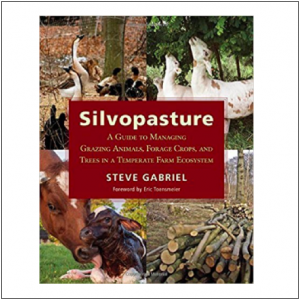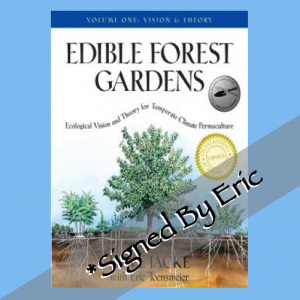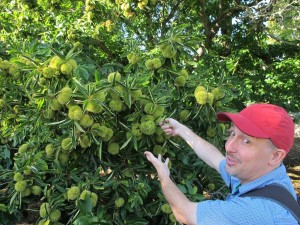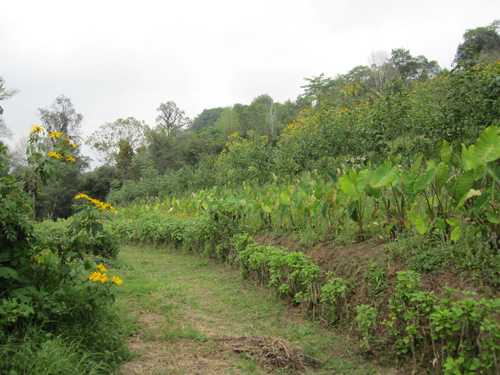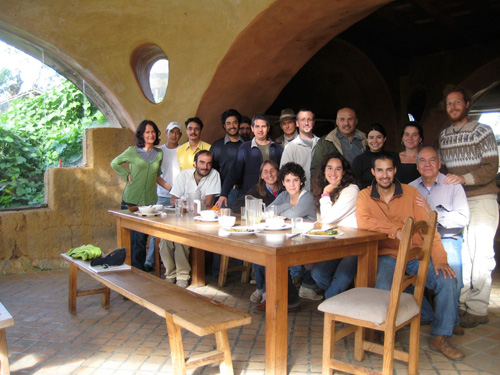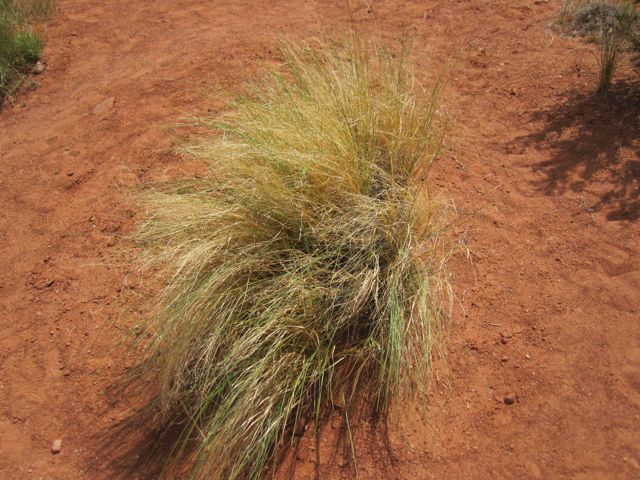One of the basic ideas of permaculture is that its principles remain the same though they are reflected uniquely in every site. Recently I’ve done plantings at two different food forestry courses that demonstrate this quite nicely.
The first course was at Woodbine Ecology Center in Sedalia Colorado. Their site is high and dry, at 7000’+ elevation (2100m), with 15″ (38cm) of precipitation, mostly coming as winter snow. Soils are poor and rocky, and the slope we were working on is steep and south-facing. Summers are hot and winters are very cold, going as low as -30F(-34C). I’m amazed anything grows there at all!
The second workshop was at the Occidental Arts and Ecology Center in Occidental, California. Their site is much lower, under 1000′ (304m) elevation, with a remarkable 90″ (238cm) of rainfall in three months and the rest of the year dry. The climate is mild and Mediterranean, warm enough for some citrus but never terribly hot or cold.
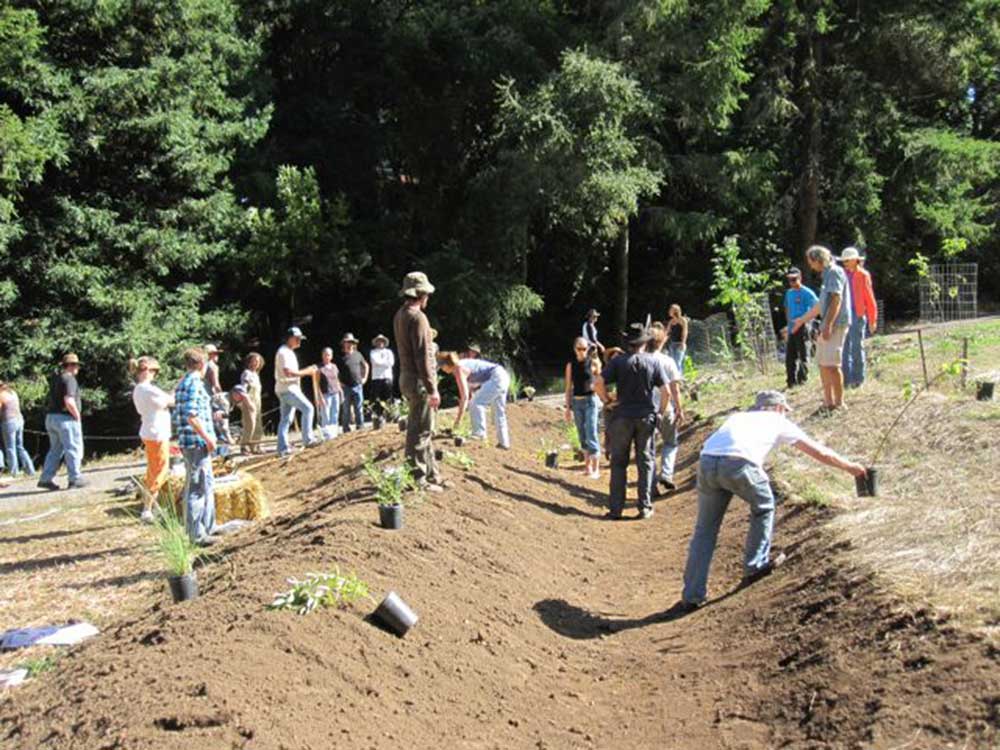

Both organizations have similar goals including permaculture demonstration and eco-cultural restoration, meaning the re-establishment of indigenous management techniques. Both sites have active eco-cultural restoration projects and indigenous groups visiting the site for educational and cultural events.
In this case we were stringing together several design patterns to make a sentence that reads “all-native useful plants + rainwater harvesting contour earthworks.” This can also be expressed mathematically as “((all-native)+(useful) x plants) * (rainwater harvesting +contour + earthworks))”, if you are a super-geek.
What is interesting to me is that this same pattern is expressed so differently on the two sites. There is not a single species overlapping, as the elevation, climates and soils are very different and there is maybe 1000 miles (1600km) between them. The swales at OAEC are much deeper and wider, reflecting a more gentle slope, higher rainwater volumes, and access to an excavator.
I’ve been enjoying planting all-native polycultures lately for several reasons. First, I think lots of us permies tend to jump to planting cool exotic stuff before we get to know the often remarkable potential of what’s beneath our feet. Second, the limitations of native species can also become apparent, making a good case for growing non-natives. Third, these sites can serve as demonstrations of indigenous management practices, which at least in the US tend to be ignored and made invisible, though they are among the best and longest-lived examples of permaculture on the planet. Fourth, these plantings can serve as germplasm banks for active eco-cultural restoration and other productive native and mixed plantings. Finally, it just plain makes for an interesting design challenge.
I’ve provided fairly complete species listings below. The OAEC planting reflects Brock Dolman’s knowledge of the importance of medicinal and fiber plants to indigenous communities, while the Woodbine planting perhaps shows my one-track mind as far as food plants, though the need for nitrogen fixation in their poor soils should also be apparent. OAEC has a number of vines, though there were really none to choose from at this dry microclimate of the Woodbine site. In contrast Woodbine has many cacti and succulents which are absent at OAEC.
Someday I hope to be part of assembling a pattern language of permaculture practices for the world’s climates, slopes, and soils, at different intensities of management. In the meantime this article is a contribution to that future endeavor, demonstrating a cluster of patterns (all-native ethnobotanical + rainwater harvesting contour earthworks) and how every species may be different but the underlying logic is the same in two very different locations.


|
OCCIDENTAL ARTS & ECOLOGY CENTER SPECIES
|
|||
|
Trees
|
|||
| Myrica californica | California wax myrtle | Nitrogen fixation | |
|
Shrubs
|
|||
| Calycanthus occidentalis | Spicebush | Medicinal, basketry | |
| Cercis occidentalis | Redbud | Flowers, basketry | |
| Cornus stolonifera | Redtwig dogwood | Medicinal, basketry | Nectary, erosion control |
| Corylus cornuta californica | Hazelnut | Nuts, basketry | |
| Garrya eliptica | Silk tassel | Medicinal | |
| Hoita macrostachya | Leatherwood | Fiber | |
| Oemleris cerasiformis | Oso berry | Fruit, medicinal | |
| Rhus ovata | Sugar bush | Fruit, medicinal, basketry | Erosion control |
| Rubus parviflorus | Thimbleberry | Fruit, medicinal | |
| Salix exigua | Grey willow | Medicinal, basketry | Erosion control |
| Sambucus mexicana | Blue elderberry | Fruit, flowers, medicinal | Nectary |
|
Vines
|
|||
| Clematis lasiantha | Pipestems | Medicinal | |
| Physocarpus capitatus | Ninebark | Medicinal | |
| Vitis californica | Wild grape | Fruit, basketry | |
|
Herbs
|
|||
| Angelica hendersonii, A. tomentosa | Angelica | Medicinal | Nectary |
| Artemisia douglasiana | Mugwort | Medicinal | |
| Camassia quamash | Camass | Bulbs | |
| Iris douglasii | Pacific iris | Medicinal | |
| Lomatium californicum | Celery weed | Tubers, greens | Nectary |
| Mimulus cardinalis | Cardinal monkey flower | Shoots, medicinal | |
| Perideridia gairdneri | Yampah | Tubers, greens, medicinal | Nectary |
| Petasites frigidus | Coltsfoot | Greens, medicinal | Nectary |
|
Grasses and Allies
|
|||
| Carex barbarae | Basket sedge | Basketry | |
| Eleocharis spp. | Spike rush | Basketry, fiber | |
| Elymus glaucus | Blue wild rye | Seeds | |
| Hordeum brachyantherum | Meadow barley | Seeds | |
| Juncus patens | Common rush | Basketry | |
| Muhlenbergia rigens | Deer grass | Seeds, basketry, fiber | |
|
Groundcovers
|
|||
| Achillea millefolium | Yarrow | Tea, medicinal | Nectary, groundcover |
| Anemopsis californica | Yerba mansa | Medicinal | |
| Aquilegia formosa | Columbine | Medicinal | |
| Asarum caudatum | Wild ginger | Medicinal | Groundcover |
| Calochortus luteus | Mariposa lily | Bulb | |
| Dicentra formosa | Bleeding heart | Medicinal | |
| Fragaria vesca | Woodland strawberry | Fruit, medicinal | Groundcover |
| Ranunculus californicus | California buttercup | Seeds | |
| Satureja douglasii | Yerba Buena | Culinary, medicinal, tea | Groundcover |


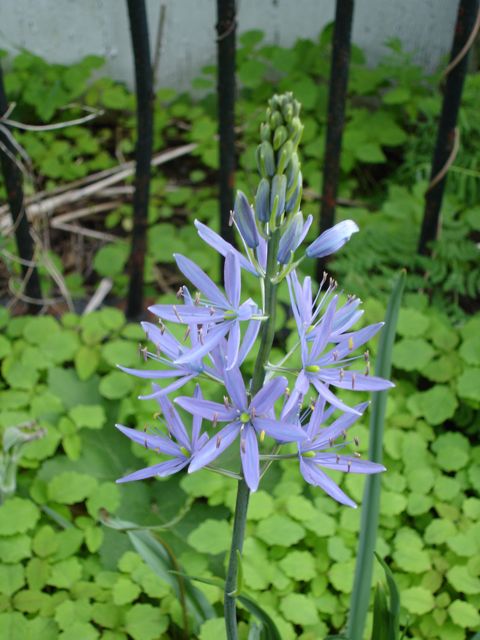


|
WOODBINE ECOLOGY CENTER SPECIES
|
|||
|
Trees
|
|||
| Celtis reticulata | Netleaf hackberry | Fruit | |
| Pinus edulis | Pinyon pine | Nuts, medicinal | |
| Quercus gambellii x Q. macrocarpa | Burgambel oak | Acorns | |
|
Shrubs
|
|||
| Amelanchier utahensis | Utah serviceberry | Fruit, basketry | |
| Amorpha fruticosa | False indigo | Nitrogen fixation | |
| Artemisia tridentata | Sagebrush | Medicinal | |
| Cercocarpus montanus | Mountain mahogany | Medicinal | Nitrogen fixation |
| Fallugia paradoxa | Apache plume | Medicinal | Nitrogen fixation |
| Prunus pumila besseyi | Sand cherry | Fruit | Erosion control |
| Rhus trilobata | Skunkbush sumac | Fruit, tea, medicinal, basketry | Erosion control |
| Ribes aureum | Golden currant | Fruit, medicinal | |
| Rubus deliciosus | Boulder raspberry | Fruit | |
| Shepherdia argentea | Silver buffalo berry | Fruit | Nitrogen fixation, erosion control |
|
Succulents
|
|||
| Cylindropuntia imbricata | Cholla cactus | Flowerbuds | |
| Echinocereus fendleri, E. coccineus | Strawberry cactus | Fruit | |
| Opuntia basilaris | Beavertail cactus | Fruit, pads | |
| Yucca baccata | Banana Yucca | Fruit, fiber | |
|
Herbs
|
|||
| Berlandiera lyrata | Chocolate flower | Culinary, medicinal | Nectary |
| Cleome serrulata | Rocky Mountain bee plant | Greens, seeds, medicinal | Nectary |
| Helianthus maximilliani | Maximilian sunflower | Shoots, seeds, roots | Nectary |
| Ipomoea leptophylla | Manroot morning glory | Giant tubers, medicinal | |
| Ratibidia columnifera | Prairie coneflower | Medicinal | Nectary |
| Stanleya pinnata | Prince’s plume | Leaves, seeds, medicinal | |
|
Grasses & Sedges
|
|||
| Oryzopsis hymenoides | Indian ricegrass | Seeds | Erosion control |
|
Groundcovers
|
|||
| Callirhoe involucrata | Purple prairie mallow | Leaves, roots | Groundcover |
| Cucurbita foetidissima | Buffalo gourd | Seeds, tuber starch, medicinal | Groundcover, erosion control |
| Dalea purpurea | Purple prairie clover | Tea, medicinal | Nitrogen fixer, groundcover, erosion control |
| Melampodium leucanthum | Blackfoot daisy | Nectary, groundcover | |
| Zinnia grandiflora | Prairie zinnia | Medicinal | Nectary, groundcover |



